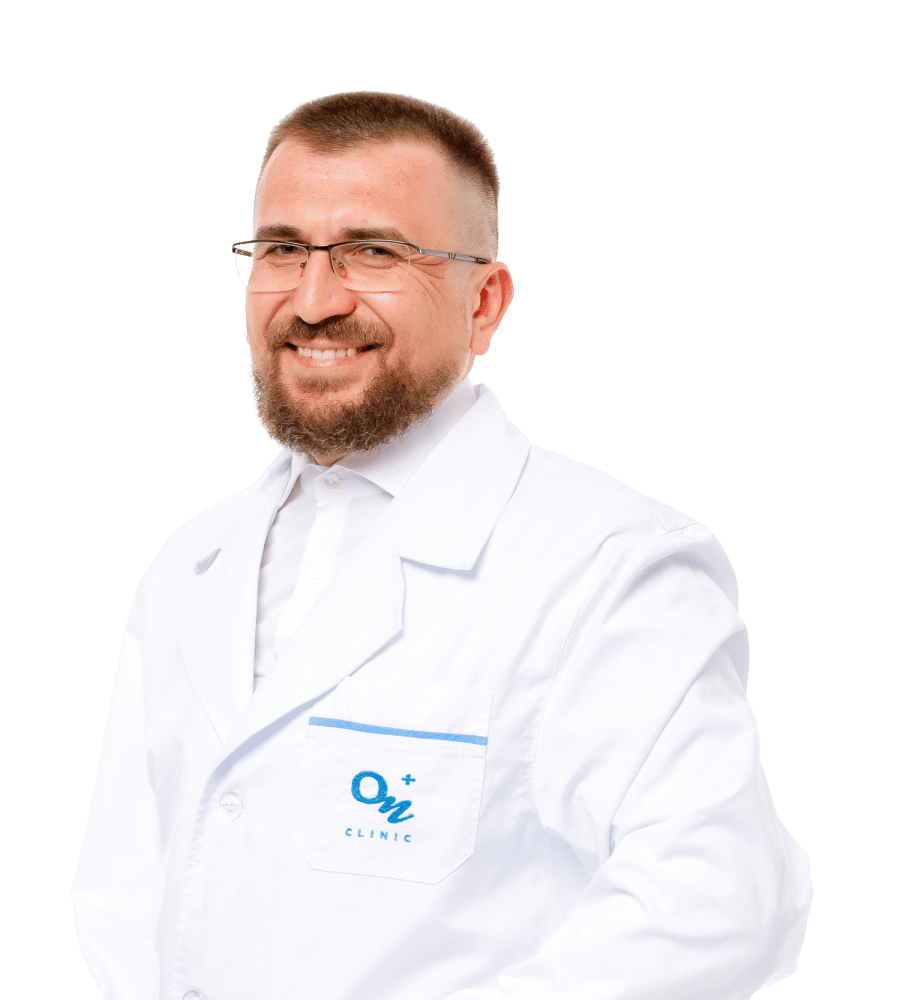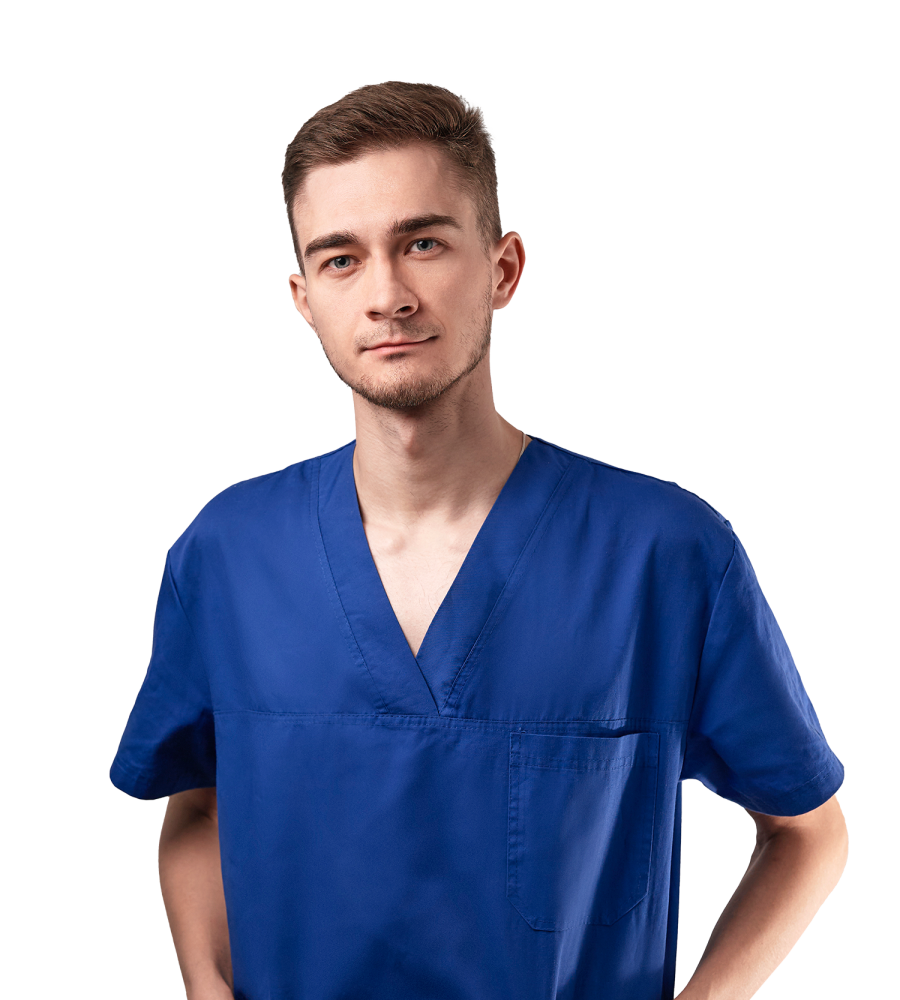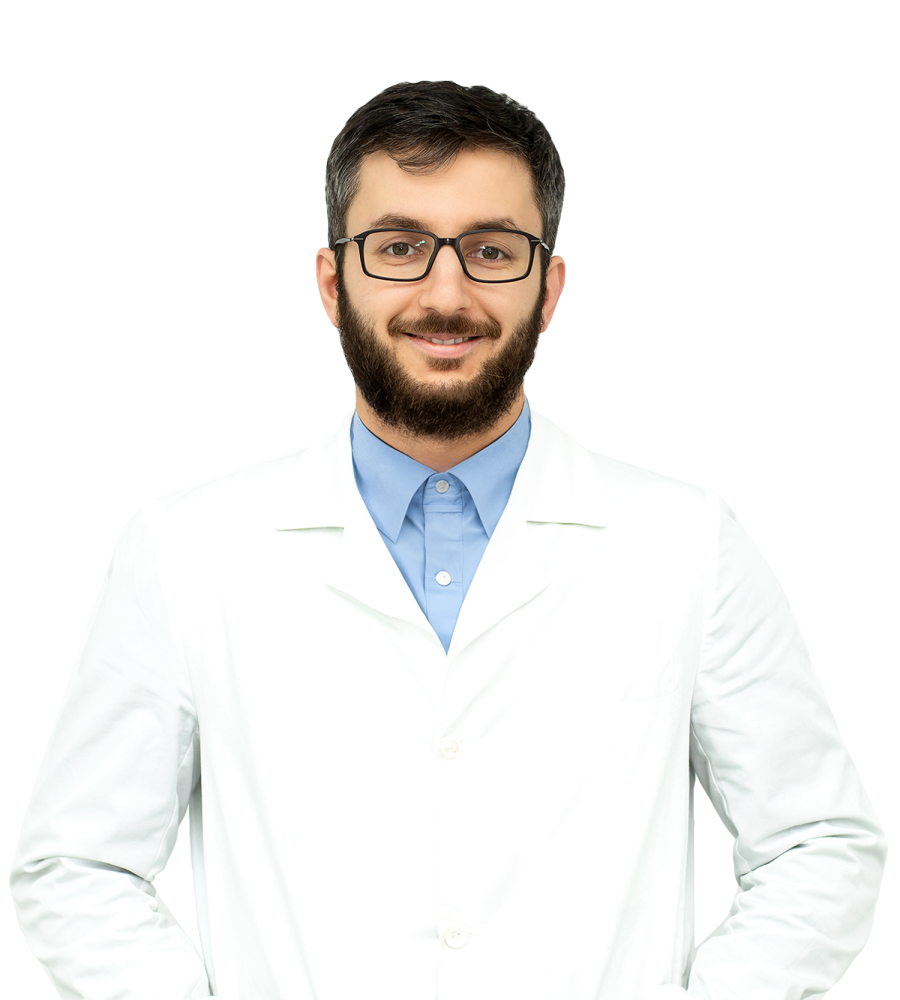Surgical treatment of hernia in Kharkov
Список выбранных услуг
Для добавления услуг с других отделений нужно закончить текущую запись.
Hernia is a protrusion of internal organs of the abdominal cavity under the skin through an area of weakened or stretched abdominal wall. Visually, it looks like a tumor with clear contours.
The hernia consists of the following:
- hernial sac formed from a stretched peritoneum - a thin shell lining the abdominal cavity from the inside;
- hernial orifice - a site of weakened muscles of the abdominal wall through which the hernia protrudes;
- contents - of an internal organ or its part located in the hernial sac.
The main manifestations of hernia are protrusion of a “bump” under the skin, pain in the abdomen or groin during sneezing, coughing, lifting weights, physical exertion or straining. In some cases, hernias are visible only when the abdominal muscles are strained and do not cause pain, so a person does not consult a doctor. But the treatment of a hernia should be started as early as possible in order to prevent its strangulation. It can lead to disturbance of blood supply and death of tissue of the restrained organ, intestinal obstruction and peritonitis - peritoneal inflammation. This condition requires emergency medical care.
The medical center “ON Clinic Kharkov” carries out the planned minimally invasive operations to remove hernias that do not require long-term rehabilitation. A few days after surgery, a patient can return to normal life.
Causes of hernia occurrence
The main causes of hernia occurrence include:
- weakness of muscle or connective tissue of the abdominal wall (congenital or acquired as a result of injuries, operations, certain diseases, aging of the body);
- increased intra-abdominal pressure. It is caused by heavy lifting, chronic severe cough, straining while going to the toilet.
The causes of umbilical hernia are also severe pregnancy and childbirth, ascites (abnormal accumulation of fluid in the abdomen), obesity, genetic predisposition.
What are the types of hernia?
Classification of hernia by its location:
- umbilical hernia - bulging of the hernial sac in the navel area. It occurs in both children and adults (mainly women). The size of umbilical hernia varies from 1-3 cm to 10 cm (rarely up to 20 cm). Way of treating umbilical hernia depends on a patient’s age: surgery is recommended for adults, drug therapy is indicated for children with uncomplicated hernia less than 1.5 cm in size;
- midline hernia — bulging of hernial sac along the abdomen midline due to the dehiscence of inner edges of the rectus muscles (diastasis). Normally, the muscles are interconnected by tendon tissue, which due to its color is also called the white line of abdomen;
- inguinal hernia - bulging of peritoneum into the groin area. It is diagnosed mainly in men and can be unilateral or bilateral;
- femoral hernia - bulging of hernial sac in the thigh area. It is diagnosed mainly in women after 45 years. Due to increase in pressure in the abdominal cavity and decrease in the elasticity of the connective tissue, hernial orifice forms in the thigh area, through which the inward parts of the body protrude (most often intestinal loops).
By its clinical progression, hernia can be:
- reducible (after pressing the hernial sac, the internals return to their places);
- irreducible (completely or partially);
- strangulated.
If a hernia appeared in adulthood, it is recommended to remove it surgically in order to prevent strangulation, which can pose a threat to life. Hernias on the abdomen are especially dangerous, since when the hernial sac is strangulated, necrosis of the strangulated tissues begins, inflammation of the peritoneum and infectious-toxic shock develop.
To diagnose a hernia, the following examination methods are used:
- external examination with palpation (hands-on);
- ultrasound;
- CT or MRI;
- laboratory tests (in case of disease complications).
Laparoscopic method of hernia removal
Surgery for hernia removal (hernioplasty) can be upfront or laparoscopic. During upfront surgery, a surgeon makes an incision in the skin at the hernia site and reduces the internals from hernial sac into abdominal cavity. Then the hernial orifice is closed with a special mesh implant. Over time, the implant becomes overgrown with connective tissue and strengthens, which is a reliable prevention of the disease recurrence.
Laparoscopic hernioplasty is a minimally invasive method for treating hernias. Unlike upfront surgery, access to the abdominal cavity is not through an incision, but through several punctures in the navel. Laparoscope - a probe equipped with a light source and a video camera that transmits the image to the monitor - is inserted into one of them. In other punctures, instruments are inserted which help a surgeon control his actions on the monitor to perform the operation. During laparoscopic surgery, a mesh implant is placed from the inside of the abdominal cavity and secured with sutures.
Laparoscopy is used to treat most types of hernias, especially to remove umbilical hernia because it does not leave noticeable marks on the skin. The benefits of this minimally invasive surgery technique are a low risk of postoperative complications, minimal intervention in the patient’s body and a short recovery period. You can make appointment for operation to remove hernia at the medical center “ON Clinic Kharkov” by calling the specified phone number or leaving a request on the website.
| Название | Цена |
| 5000 uah | |
| 600 uah | |
| 850 uah | |
| 5500 uah | |
| 4500 uah | |
| 280 uah | |
| 2075 uah | |
| Consultation of an oncogynecologist | 700 uah |
| Consultation with a surgeon | 600 uah |
| Consultation with a surgeon-endocrinologist | 525 uah |
| Consultation with an oncosurgeon | 600 uah |
| Consultation with an operating obstetrician-gynecologist | 500 uah |
| Consultation with an operating surgeon | 500 uah |
| Consultation with an operating urologist | 550 uah |
| Endocrinology surgeon consultation | 600 uah |
| Home call to a surgeon | 1800 uah |
| ONLINE Consultation with a gynecological oncologist | 700 uah |
| ONLINE Consultation with a surgeon | 600 uah |
| ONLINE Consultation with an oncosurgeon | 600 uah |
| ONLINE Consultation with an surgeon-endocrinologist | 525 uah |
| ONLINE Thoracic Surgeon Consultation | 600 uah |
| Thoracic surgeon consultation | 500 uah |
The cost of appointments surgeon in Kharkiv
Другие услуги Surgery в Kharkiv
Список выбранных услуг
Для добавления услуг с других отделений нужно закончить текущую запись.















